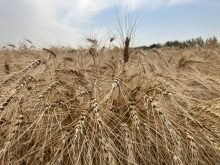SYDNEY, Dec 3 (Reuters) – A bumper Australian wheat crop will help feed increased demand from China, traders said on Tuesday, after the government’s forecaster unexpectedly raised its estimate of the upcoming harvest to the third biggest on record.
Chinese demand for Australia’s wheat has resurfaced after a poor domestic crop, leading to forecasts that the world’s biggest wheat producer could import up to 7.5 million tonnes globally in 2013/14.
The Australian Bureau of Agriculture and Resource Economics and Sciences (ABARES) forecast wheat output in 2013/14 of 26.2 million tonnes, up 7 percent from its previous estimate in September, citing good rains across the country’s southwest.
Read Also

Draft ‘MAHA’ commission report avoids pesticide crackdown feared by farm groups
The White House will not impose new guardrails on the farm industry’s use of pesticides as part of a strategy to address children’s health outcomes, according to a draft obtained by Reuters of a widely anticipated report from President Donald Trump’s ‘Make America Healthy Again’ commission.
The increase was driven by a 31 percent jump in the forecast harvest for the largest grain producing state Western Australia, which outweighed a lower forecast in eastern states.
“We see continued demand from China and expect to see increased flow of wheat,” said Tom Puddy, head of marketing at CBH Group, the state’s largest seller of wheat. He declined to give details of specific deals.
China had bought more than 2 million tonnes of Australian wheat by September, an official China think-tank said, although some traders estimate sales at between 3 million and 4 million tonnes.
Official figures are not released for Australian wheat sales to China and traders are reluctant to discuss specific deals as Chinese buyers prefer to operate away from the market spotlight.
A large crop from Australia, the world’s second-largest wheat exporter, comes amid expectations of a strong global harvest.
SURPRISE INCREASE
The market had been bracing for a downgrade to the previous forecast due to frost across Australia’s eastern growing states of New South Wales and Queensland.
The bureau said production was expected to fall nearly 12 percent to 7.85 million tonnes in the eastern states, but this was more than offset by timely rains across central and southern Western Australia that boosted yields.
“Rains in September came too late for wheat in northern Western Australia, but the southern region enjoyed good spring rains throughout,” said Peter Collins, manager of agricultural commodities at ABARES.
“When we did our last report in September, the central zones were sitting on a knife edge, and the rains came just at the right time.”
Wheat prices had reached a near one-month high on Monday, underpinned by production concerns in Australia, and also in Argentina.
Chicago Board of Trade wheat futures edged higher on on Tuesday on bargain buying after the grain fell 1 percent in the previous session, although analysts said the Australian production forecast was capping gains.
Australian grain handler GrainCorp flagged potential production shortfalls across the east coast in November.
Australia posted its record wheat crop of 29.2 million tonnes in 2011/12.














